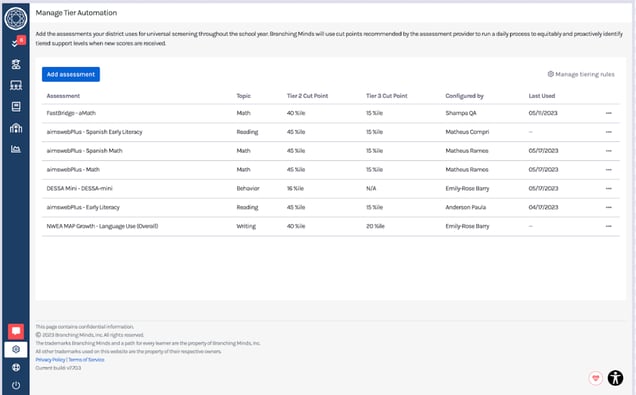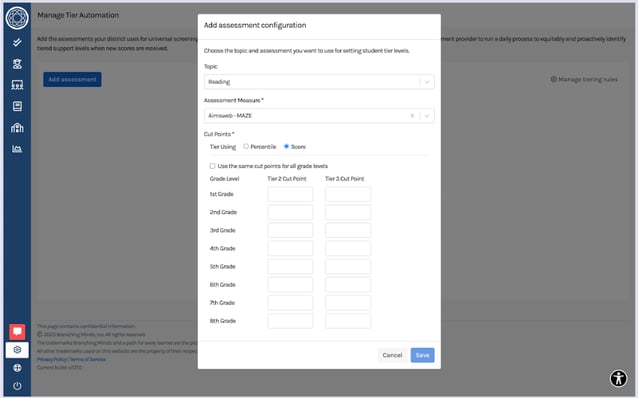Based on an analysis of Spring 2023 Map Growth assessment data, the NWEA Research Policy Brief* revealed that achievement gains in the 2022–23 academic year fell short of pre-pandemic trends across most grades, hampering progress toward pandemic recovery. Significant achievement gaps persist, with the average student needing 4.1 additional months of schooling in reading and 4.5 months in math to catch up.
Notably, all students, particularly marginalized ones, lagged behind pre-pandemic trends in achievement gains. In light of these disparities, educational institutions must systematically identify and support students requiring extra assistance. Universal screening is pivotal, allowing educators to objectively determine students' support levels in various subjects. This data helps tailor interventions and instruction.
However, systematically implementing tiered support poses challenges for administrators and educators. To address these issues, a centralized solution in universal screening and tiering is imperative. The absence of such a platform complicates data aggregation, decision-making, and interpretation of screener data. Challenges like labor-intensive data gathering and inconsistency in tier determination arise due to decentralized decision-making. This diversion of educator time away from direct student support underscores the necessity of a comprehensive platform to streamline data use and ease these complexities.
*Source: Lewis, K. & Kuhfeld, M. (2023). Education’s long COVID: 2022–23 achievement data reveal stalled progress toward pandemic recovery. NWEA
Enter Tier Automation
The Branching Minds platform provides a comprehensive solution to the use of universal screener data for tier identification. Its Tier Automation feature is a powerful tool designed to streamline the process by applying consistent cut points for assessments across all academic topics, as well as SEL & Behavioral Health. Student tier change events are then automatically created when Branching Minds receives new assessment data for a student within each screening window. This ensures that student tier recommendations are objective and systematically applied across the district, with up-to-date changes for support planning available in the platform within minutes of new assessment data being ingested.
Saved Time & Effort
- Automatic tier recommendations based on new assessment data, eliminating manual efforts for administrators.
Immediate Need Identification
- Teachers access student support plans within minutes of new benchmark or screener data.
Objective & Consistent Tiers
- Standardized cut points ensure objective support identification across the district.
Multiple Assessment Tiering
- Accommodates various screening assessments, including different languages.
- Default tier recommendations can be adjusted based on students' needs.
Customizable Options
- Use recommended cut points or set custom thresholds for Tier 2 and Tier 3 support.
|
|
Flexibility in Assessments
- Choose from a wide range of assessments, including nationally normed universal screeners or local benchmarks.

|
Real-Time Tier Monitoring
- Automatic updates of student tier levels for each screening window.
- Branching Minds reporting enables easy review of tier movement at a systems level.
Case Study: A Path to Progress
Greene County Schools partnered with Branching Minds to enhance their Multi-Tiered System of Supports (MTSS) with efficient data tracking and student support identification. The 2020-2021 implementation showcased strong outcomes, reinforcing the value of Screening and Tiering in the MTSS framework.
Key Implementation-Based Outcomes:
- Tier 2 and 3 Support Plans: Elementary and middle schools successfully developed support plans for a significant majority (61%) of students identified as needing Tier 2 and 3 interventions.
- Evidence-Based Interventions: The adoption of BRM led to an impressive 88% utilization of evidence-based interventions and supports within the intervention plans.
BRM interventions spurred impressive growth. Math students achieved a 35-point spring increase while reading interventions led to a 17-point rise, notably impactful for third to fifth-graders.
Greene's success exemplifies the potential of MTSS Screening and Tiering through Branching Minds. Documented interventions propelled struggling students to significant academic strides. This approach empowers leaders to enhance practices, adhere to guidelines, and nurture student success.
>> Explore the full case study to delve deeper into these remarkable outcomes.
Embracing Tier Automation
The use of universal screener data in tier identification is an essential component of a successful Multi-Tiered System of Supports. Branching Minds empowers district and campus administrators to implement a streamlined, data-driven, and objective approach to student support with features like Tier Automation. By saving administrative time, ensuring immediate need identification, removing the potential for biases in decision-making and resource allocation, and offering customizable tiering rules, the Branching Minds platform ensures your needs identification system is objective and routine.
|
|
🚀 Transform Your Approach to Screening & TieringLearn more about the power of Tier Automation and its potential to transform your educational institution's approach to universal screening and tiering.
|
|

Your MTSS Transformation Starts Here
Enhance your MTSS process. Book a Branching Minds demo today.
















![[Guest Author] Nikki Dickens-avatar](https://www.branchingminds.com/hs-fs/hubfs/Team/IMG_2745.jpeg?width=82&height=82&name=IMG_2745.jpeg)


.png?width=716&height=522&name=Tier%203%20Behavior%20Support%20Planning%20(preview).png)